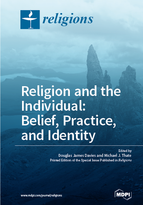Religion and the Individual: Belief, Practice, and Identity
A special issue of Religions (ISSN 2077-1444).
Deadline for manuscript submissions: closed (15 April 2016) | Viewed by 83908
Special Issue Editors
Interests: death, ritual and belief; Mormon religion; sociology and anthropology of religion; emotions and religion
Special Issue Information
Dear Colleagues,
This Special Issue is both experimental and comparative. It appropriates diverse disciplinary idioms from the distinctive fields our authors inhabit to focus on the ever-recurrent theme of the individual and the study of religion. Here the familiar topics of "belief", "practice" and "identity" come into conversation with each other from scholars in anthropology, sociology, African-American history, Asian religions, philosophy, religious studies, critical theory, and ancient history. This unashamedly eclectic venture demonstrates both the remarkable diversity enacted by the signifier, “religious”, and the dynamic potential of conversation between interesting scholars working on remarkably interesting topics.
Prof. Dr. Douglas James Davies
Dr. Michael J. Thate
Guest Editors
Manuscript Submission Information
Manuscripts should be submitted online at www.mdpi.com by registering and logging in to this website. Once you are registered, click here to go to the submission form. Manuscripts can be submitted until the deadline. All papers will be peer-reviewed. Accepted papers will be published continuously in the journal (as soon as accepted) and will be listed together on the special issue website. Research articles, review articles as well as short communications are invited. For planned papers, a title and short abstract (about 100 words) can be sent to the Editorial Office for announcement on this website.
Submitted manuscripts should not have been published previously, nor be under consideration for publication elsewhere (except conference proceedings papers). All manuscripts are thoroughly refereed through a double-blind peer-review process. A guide for authors and other relevant information for submission of manuscripts is available on the Instructions for Authors page. Religions is an international peer-reviewed open access monthly journal published by MDPI.
Please visit the Instructions for Authors page before submitting a manuscript. Submitted papers should be well formatted and use good English. Authors may use MDPI's English editing service prior to publication or during author revisions.
Keywords
- Pentecostalism
- Belief
- Catholic-Jewish relations
- Yoga
- Money and Time
- Capitalism
- missionaries
- east Asian religions
- Jazz and African-American History
- automation
- wine and food






